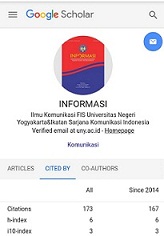The government website as user's information source: A model of user satisfaction, information, and system quality
DOI:
https://doi.org/10.21831/informasi.v53i2.60579Keywords:
Website, Information Quality, System Quality, User SatisfactionAbstract
The Ministry of Religious Affairs of the Republic of Indonesia uses a website to disseminate news and publications to the public. An effective strategy for developing a successful website is to build a positive user experience that leads to a positive attitude from users towards the website. User experience in terms of optimizing website utilization has not been well explored, especially regarding satisfaction. Satisfaction is influenced by information quality and system quality factors. Information quality encompasses 5 variables (completeness, accuracy, format, currency, availability) and system quality consists of nine variables (reliability, flexibility, accessibility, responsiveness, integration, usability, functionality, design appeal, efficiency). This study assessed the effect of information quality and system quality on the satisfaction of using the Ministry of Religious Affairs' website. The target population of this study were all users who had accessed the website at least once in the last three months. The data were collected from 420 respondents and analyzed using PLS-SEM. The findings indicated that the hypothesis of the variables completeness, accuracy, format, currency, availability, reliability, flexibility, accessibility, responsiveness, integration, usability, and functionality is not supported. However, the results of this research confirmed the positive and significant effect of design appeal and efficiency on satisfaction.
References
Abu-Shanab, E., & Abu-Baker, A. N. (2011). Evaluating Jordan's e-government website: a case study. Electronic Government, an International Journal, 8(4), 271. https://doi.org/10.1504/EG.2011.042807
Agrawal, G., Kumar, D., Singh, M., & Dani, D. (2019). Evaluating accessibility and usability of airline websites. In Communications in Computer and Information Science (Vol. 1045, Issue April). Springer Singapore. https://doi.org/10.1007/978-981-13-9939-8_35
Al-Hawary, S. I. S., & Al-Menhaly, S. M. (2016). The Quality of E-Government Services and its Role on Achieving Beneficiaries Satisfaction The Quality of E-Government Services and its Role on Achieving Beneficiaries Satisfaction Applied Study in Ministry of Interior of United Arab Emirates. Type: Double Blind Peer Reviewed International Research Journal Publisher: Global Journals Inc, 16(11).
Alsudani, F., & Casey, M. (2009, September). The Effect of Aesthetics on Web Credibility. https://doi.org/10.14236/ewic/HCI2009.64
Belanche, D., Casaló, L. V., & Guinalíu, M. (2012). Website usability, consumer satisfaction and the intention to use a website: The moderating effect of perceived risk. Journal of Retailing and Consumer Services, 19(1), 124–132. https://doi.org/10.1016/j.jretconser.2011.11.001
Bhanu, J. S., Kamesh, D. B. K., & Sastry, J. K. R. (2019). Assessing completeness of a WEB site from Quality Perspective. International Journal of Electrical and Computer Engineering, 9(6), 5596–5603. https://doi.org/10.11591/ijece.v9i6.pp5596-5603
Bucko, J., & KakalejÄík, L. (2018). Website usability and user experience during shopping online from abroad. E a M: Ekonomie a Management, 21(3), 205–219. https://doi.org/10.15240/tul/001/2018-3-013
Casare, A., Basso, T., & Moraes, R. (2020). Trust metrics to measure website user experience. The Thirteenth International Conference on Advances in Computer-Human Interactions, c, 1–8.
Chen, C.-C., & Chang, Y.-C. (2018). What drives purchase intention on Airbnb? Perspectives of consumer reviews, information quality, and media richness. Telematics and Informatics, 35(5), 1512–1523. https://doi.org/10.1016/j.tele.2018.03.019
Christin, A. (2018). Counting clicks: Quantification and variation in web journalism in the United States and France. American Journal of Sociology, 123(5), 1382–1415. https://doi.org/10.1086/696137
Delima, R., Santosa, H. B., & Purwadi, J. (2017). Development of Dutatani Website Using Rapid Application Development. IJITEE (International Journal of Information Technology and Electrical Engineering), 1(2), 36–44. https://doi.org/10.22146/ijitee.28362
Dhingra, S., Gupta, S., & Bhatt, R. (2020). A study of relationship among service quality of E-Commerce websites, customer satisfaction, and purchase intention. International Journal of E-Business Research, 16(3), 42–59. https://doi.org/10.4018/IJEBR.2020070103
Fu, X., & Juan, Z. (2017). Understanding public transit use behavior: integration of the theory of planned behavior and the customer satisfaction theory. Transportation, 44(5), 1021–1042. https://doi.org/10.1007/s11116-016-9692-8
Gamble, K. R., Cassenti, D. N., & Buchler, N. (2018). Effects of information accuracy and volume on decision making. Military Psychology, 30(4), 311–320. https://doi.org/10.1080/08995605.2018.1425586
Hair, J. F., Babin, B. J., Anderson, R. E., & Black, W. C. (2019). Multivariate Data Analysis (8th ed.). Cengage Learning.
Hepp, A., Hjarvard, S., & Lundby, K. (2015). Mediatization: theorizing the interplay between media, culture and society. Media, Culture and Society, 37(2), 314–324. https://doi.org/10.1177/0163443715573835
Iazzi, A., Vrontis, D., Trio, O., & Melanthiou, Y. (2016). Consumer preference, satisfaction, and intentional behavior: Investigating consumer attitudes for branded or unbranded products. Journal of Transnational Management, 21(2), 84–98. https://doi.org/10.1080/15475778.2016.1167000
Komodromos, M. (2016). How web 2.0 and social media are changing public relations practitioners' work: A qualitative study. International Journal of Technology Enhanced Learning, 8(1), 48–58. https://doi.org/10.1504/IJTEL.2016.075951
Kurniawan, F., Rakhmawati, N. A., Abadi, A. N., Zuhri, M., & Sugiyanto, W. T. (2017). Indonesia local government information completeness on the web. Procedia Computer Science, 124, 21–28. https://doi.org/10.1016/j.procs.2017.12.125
Lee, S. K., & Min, S. R. (2021). Effects of Information Quality of Online Travel Agencies on Trust and Continuous Usage Intention: An Application of the SOR Model. Journal of Asian Finance, Economics and Business, 8(4), 971–982. https://doi.org/https://doi.org/10.13106/jafeb.2021.vol8.no4.0971
Li, C.-F., & Jiang, Y.-Q. (2019). Research on the Optimization Method of Website Based on User Experience. In Advances in Usability, User Experience and Assistive Technology (pp. 412–421). Springer, Cham. https://doi.org/10.1007/978-3-319-94947-5_42
Macnamara, J. (2010). Public communication practices in the Web 2 . 0-3 . 0 mediascape : The case for PRevolution Jim Macnamara University of Technology Sydney. Prism Journal, 7(January 2010), 1–13.
Nelson, R. R., Todd, P. A., & Wixom, B. H. (2005). Antecedents of Information and System Quality: An Empirical Examination Within the Context of Data Warehousing. Journal of Management Information Systems, 21(4), 199–235. https://doi.org/10.1080/07421222.2005.11045823
Pengnate, S. (Fone), & Sarathy, R. (2017). An experimental investigation of the influence of website emotional design features on trust in unfamiliar online vendors. Computers in Human Behavior, 67(July), 49–60. https://doi.org/10.1016/j.chb.2016.10.018
Pengnate, S. (Fone), Sarathy, R., & Lee, J. (2018). The Engagement of Website Initial Aesthetic Impressions: An Experimental Investigation. International Journal of Human–Computer Interaction, 35(16), 1517–1531. https://doi.org/10.1080/10447318.2018.1554319
Rahardjo, E., Mirchandani, D., & Joshi, K. (2007). E-Government Functionality and Website Features: A Case Study of Indonesia. Journal of Global Information Technology Management, 10(1), 31–50. https://doi.org/10.1080/1097198X.2007.10856437
Rita, P., Oliveira, T., & Farisa, A. (2019). The impact of e-service quality and customer satisfaction on customer behavior in online shopping. Heliyon, 5(10), e02690. https://doi.org/10.1016/j.heliyon.2019.e02690
Sachan, A., Kumar, R., & Kumar, R. (2018). Examining the impact of e-government service process on user satisfaction. Journal of Global Operations and Strategic Sourcing, 11(3), 321–336. https://doi.org/10.1108/JGOSS-11-2017-0048
Safdar, G., Javed, M. N., & Amin, S. (2020). Use of internet for education learning among Female University Students of Punjab, Pakistan. Universal Journal of Educational Research, 8(8), 3371–3380. https://doi.org/10.13189/ujer.2020.080809
Sahoo, S. K., & Mohapatra, J. P. (2019). Online Public Relations, Use of Website and Social Media by State PSUs in Odisha. International Journal of Communication and Media Studies, 9(2), 9–22. https://doi.org/10.24247/ijcmsapr20192
Schumacker, R. E., & Lomax, R. G. (2016). A Beginner's Guide to Structural Equation Modeling: Fourth Edition (4th ed.). Routledge.
Simanjuntak, M. L., Mansur, S., Saragih, N., Hayati, S., & Endri, E. (2022). The role of quality and trust on using website news. International Journal of Data and Network Science, 6(3), 683–692. https://doi.org/10.5267/j.ijdns.2022.4.004
Sivaji, A., & Tzuaan, S. S. (2012). Website user experience (UX) testing tool development using Open Source Software (OSS). 2012 Southeast Asian Network of Ergonomics Societies Conference (SEANES), 1–6. https://doi.org/10.1109/SEANES.2012.6299576
Straubhaar, J., LaRose, R., & Davenport, L. (2012). Media Now: Understanding Media, Culture and Technology (7th ed.). Wadsworth Cencage Learning.
Suryani, T., Fauzi, A. A., & Nurhadi, M. (2020). The Determinant of Website Quality and E- Service Quality At Sme in Indonesia. Jurnal Manajemen Dan Kewirausahaan, 22(2), 131–141. https://doi.org/10.9744/jmk.22.2.131-141
Toma, T. R., Mahmud, I., Hossain, M. E., Jahan, N., Ramayah, T., & Jayapal, P. (2018). To Read or Not to Read: Modeling Online Newspaper Reading Satisfaction and Its Impact on Revisit Intention and Word-Of-Mouth. Interdisciplinary Journal of Information, Knowledge, and Management, 13, 337–359. https://doi.org/10.28945/4118
Tseng, F.-C., Huang, T.-L., Cheng, T. C. E., & Teng, C.-I. (2022). Evaluating e-commerce website qualities: personality traits as triggers. Internet Research, 33(2), 741–773. https://doi.org/10.1108/INTR-01-2021-0001
Veeramootoo, N., Nunkoo, R., & Dwivedi, Y. K. (2018). What determines success of an e-government service? Validation of an integrative model of e-filing continuance usage. Government Information Quarterly, 35(2), 161–174. https://doi.org/10.1016/j.giq.2018.03.004
Vila, T. D., González, E. A., Vila, N. A., & Brea, J. A. F. (2021). Indicators of website features in the user experience of e-tourism search and metasearch engines. Journal of Theoretical and Applied Electronic Commerce Research, 16(1), 18–36. https://doi.org/10.4067/S0718-18762021000100103
Widagdo, B., & Roz, K. (2021). Hedonic Shopping Motivation and Impulse Buying: The Effect of Website Quality on Customer Satisfaction. Journal of Asian Finance, Economics and Business, 8(1), 395–405. https://doi.org/10.13106/jafeb.2021.vol8.no1.395
Downloads
Published
How to Cite
Issue
Section
Citation Check
License
Authors who publish with this journal agree to the following terms:- Authors retain copyright and grant the journal right of first publication with the work simultaneously licensed under a Creative Commons Attribution License that allows others to share the work with an acknowledgement of the work's authorship and initial publication in this journal.
- Authors are able to enter into separate, additional contractual arrangements for the non-exclusive distribution of the journal's published version of the work (e.g., post it to an institutional repository or publish it in a book), with an acknowledgement of its initial publication in this journal.
- Authors are permitted and encouraged to post their work online (e.g., in institutional repositories or on their website) prior to and during the submission process, as it can lead to productive exchanges, as well as earlier and greater citation of published work (See The Effect of Open Access).























